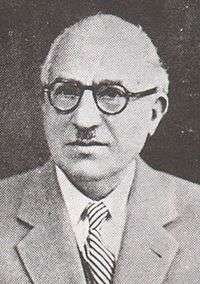Isa Sedigh
| Isa Sedigh | |
|---|---|
| عیسی صدیق | |
 | |
| Ministry of Education | |
|
Assumed office 20 September 1931 | |
| Monarch | Mohammad Reza Pahlavi |
| Prime Minister | Mohammad Ali Foroughi |
| Preceded by | Esmail Merat |
| Succeeded by | Seyed Mohammad Tadayon |
| 3rd president of University of Tehran | |
| Personal details | |
| Born |
June 18, 1894 Tehran |
| Died |
June 5, 1978 (aged 83) Tehran |
| Resting place | Alijan garden, Rey, Iran |
| Citizenship |
|
| Nationality |
|
| Mother | Khadijeh Beygam |
| Father | Abdollah Sedigh Al-Tojar Isfahani |
| Religion | Islam |
Isa Sedigh, also known as Sedigh Alam (meaning "the knowledgeable Sedigh"), was minister of education in Iran, and the 3rd president of the University of Tehran.[1]
Early life and education
Isa Sedigh was born in June 1894 in Hammam Ghebleh, Tehran. His father Mirza Abdollah Shamloo, also known as Abdollah Sedigh Al-Tojar Isfahani, was a grandson of Mirza Mehdi Khan Astarabadi.[2]
Isa Sedigh finished his undergraduate education in Kamalieh School and Dar ul-Funun. After finishing school, he traveled to France with the first student expedition in 1911. In 1918, he completed his education in Versailles, Yvelines, receiving his bachelor's degree in mathematics from the University of Paris.[3]
In 1930, upon receiving an invitation to study at Columbia University, Sedigh went to United States and, after one year, received his doctorate in Philosophy.[4]
Career
Isa Sedigh was a member of the Socialist Party. He worked in the University of Cambridge as an assistant teacher of professor Edward Granville Browne in Persian literature. After returning to France he made Persian one of his foreign languages, which students could choose as their foreign language course.[2]
While Iran was under attack by the Russian empire, Sedigh wrote many related articles in The Times.
He returned to Iran in 1918; just after his arrival, he was selected as inspector of schools. He worked as the head of the education organization of Gilan Province.[5]
Isa Sedigh served as chief of staff of the Ministry of Justice in Iran.
In 1921, he received the title of Sedigh Alam from Ahmad Shah Qajar per Samad Khan Momtaz os-Saltaneh's request.
He was a member of the Iranian constituent assembly when it officially began in 1921.
When Ali-Akbar Davar founded the Radical party, Isa was selected as vice president.
During his education in Columbia University, Abdolhossein Teymourtash asked Sedigh to plan the founding of a Dar ul-Funun (university) in Tehran. (Isa used the word Daneshgah (meaning a university) instead of Dar ul-Funun (meaning a complex institute for teaching various courses)) After returning to Iran in 1931, Reza Shah commanded him to found the University of Tehran.[6]
He selected as minister of education in Mohammad Ali Foroughi's first cabinet on September 21, 1941; two years later, he was selected again for this position in Ali Soheili's cabinet. Sedigh maintained this position in Morteza-Qoli Bayat's (November 25, 1944) and Ahmad Qavam's (September 11, 1947) cabinets. Jafar Sharif-Emami selected him on October 11, 1960 as minister of education for the 6th time.
He was a member of the Iranian senate in its first term in 1949.[7] He was also elected in its 2nd, 4th, 5th and 7th terms.[5]
Death
Isa Sedigh died on June 5, 1978 in Tehran and was buried in Behesht-e Zahra.[3]
Publications
Some of his publications: [2]
- Fundamentals of math and intellectual problems, 1923
- 100 solved math problems, 1923
- Industry of Iran in past and future, 1925
- Scientific principles of education, 1928
- One year in the United states, 1932
- Modern method of education and training, 1935
- Brief history of Iran's culture, 1937
- History of Iranian culture, 1957
See also
References
- ↑ Education and training in Iran (in Persian). Cultural Research Bureau. 2006. pp. 87,88. ISBN 964-379-092-4.
- 1 2 3 "Isa Sedigh". IBNA (in Persian). 2015. Retrieved 27 November 2016.
- 1 2 "Dr. Isa Sedigh's death". Samenea (in Persian). Tehran: Samenea. Retrieved 27 November 2016.
- ↑ Yaghmaee, Eghbal (1996). Minister of education of Iran (in Persian). Tehran: Center of university publication. pp. 341_353.
- 1 2 "Biography of Isa Sedigh". Ghazavatonline (in Persian). 2016. Retrieved 27 November 2016.
- ↑ Sedigh. Yadegar-e omr (in Persian). pp. 1338–1352.
- ↑ Biography of Iran's nobelmen (in Persian). Asarafarinan.